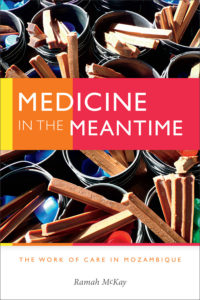Reviewed Book
Medicine in the Meantime: The Work of Care in Mozambique. Ramah McKay, Durham: Duke University Press, 2018, 256 pp.

Ramah McKay’s Medicine in the Meantime provides a nuanced account of the layering, sedimentation, and erosion of health-related projects in Mozambique. By including both public and non-governmental forms of care, McKay allows her readers to consider these forms of intervention together. While public health and global health are sometimes thought of as separate or parallel systems, McKay shows how they form a palimpsest of partial erasures and overlays. Through her historical accounts, which she manages to make both detailed and accessible, and her vivid ethnography, she shows her readers how a multiplicity of resources, practices, and norms shape the lives of clinicians, patients, and their families. Rather than thinking of each health-related intervention as a separate and separable incident, McKay shows us how memories, materials, and embodied traces of relational practice remain and shape what follows.
McKay conducted the majority of her fieldwork at sites belonging to two medical projects in Mozambique. The first, the International Center for Health Care (ICHC), is a large AIDS care and treatment organization funded by the U.S.’s President’s Emergency Plan for AIDS Relief (PEPFAR) and run by the faculty of a large midwestern U.S. school of public health.
McKay’s writings on ICHC are based on her fieldwork at an urban hospital and periurban clinic, both located in Mozambique’s capital city, Maputo, in the southern part of the country. The second, the Global Children’s Fund (GCF), is a U.K.-based aid agency that had recently shifted to a more medical focus. McKay’s work with GCF was focused on its AIDS and psychosocial interventions in Morrumbala district, in northern Mozambique.
McKay sees these two sets of sites as partially connected, and she seeks less to draw a contrast between them than to show how the appearance of transnational biomedicine is shaped by the prior histories that came before each of these organizations landed in their respective sites. While I appreciate the subtlety of this approach, I sometimes wondered if bringing out a sharper contrast between the two sets of sites might have clarified McKay’s argument, or whether choosing only one of the two organizations might have made for a smoother read. As a reader, I sometimes found it difficult to keep track of all of the people and field sites, and I would imagine that students might run into similar problems. While some people and places, like the psychologist Dr. Luísa at Clínica 2, stayed with me long after I finished reading the book, I found that others were harder to remember.
It is perhaps no surprise that Dr. Luísa was among those who stayed with me. She was among those to whom McKay herself felt most drawn. She is there from the first pages to the last. Further, it is in the book’s later chapters that McKay’s ethnographic descriptions are at their sharpest and most original. Here we see how the passage of time, the appearance and disappearance of certain kinds of opportunities, and norms of care, clinical practice, and record keeping have shaped the careers of people like Dr. Luísa and their ways of inhabiting the clinic. For example, in a particularly excellent passage in Chapter 5, McKay shows us how Drs. Luísa, Felícia, and Carolina variously navigate the bind between speaking in Portuguese, a language that can be readily understood by the foreign doctors and volunteers, and Changana, a language necessary for communicating clearly with some patients. In this passage, McKay deftly describes how the professional insecurities felt by people like Drs. Luísa and Felícia, who had neither elite connections nor medical degrees, necessitated a performative distancing from Changana as they attempted to secure their tenuous claims on the exclusive cosmopolitanism of global health. While the book as a whole would make a good choice for classes on global health and development, Chapter 5 would also work well as a stand-alone reading, and I think that many students headed off for summers or careers in global health work would greatly benefit from reading it.
While this book confirms many of the arguments found in the large and ever-growing anthropological literature on global health, McKay’s efforts to untangle and describe the numerous material resources, ideologies, and practices that have come together over decades to shape relations of care in contemporary Mozambique will greatly enrich anthropological conversations on health, transnational governmentality, and the state. By allowing her readers to see both how this dense weave has come into being and how it is lived in the present, McKay pushes past claims about state and non-state, public and private. Her argument has important implications for thinking about the proper state of relations between government-sponsored health projects and institutions and the transnational assemblages of global health, and it will likely find a wide audience both within and beyond medical anthropology.